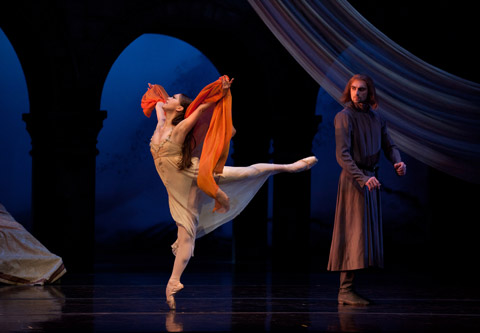
DRAMATIC CHALLENGE Misa Kuranaga captured the teenaged willfulness and despair of the character in both her dancing and her acting. |
Shakespeare's Romeo and Juliet has probably inspired as many ballet translations as The Rite of Spring. For different reasons. While Stravinsky and Nijinsky's Rite was a shocker that begged for redemption, Romeo is cathartic — a love story we never tire of. Choreographers can't resist the tragic tale of innocence driven to destruction by a cruel and petty social order, even if they're going to tweak it. In John Cranko's 1963 version, the forbidden romance plays out almost in private, against the spectacle of town and ballroom, but he omits the moral lesson, the remorseful truce between the feuding familiesBoston Ballet took Cranko's Romeo into the repertory three years ago and the production has returned to the Opera House (through November 13). It was staged by Benesh notator Jane Bourne, who joined Cranko's Stuttgart Ballet shortly after his death in 1973 and has directed many of his ballets for other companies as well as Boston.
Romeo and Juliet is a very long, old-fashioned story ballet, with Prokofiev's 1936 orchestral score summoning opulent costumes, boisterous peasants, dueling aristocrats, and the desperate lovers. Despite retreating into 19th-century classical conventions, Cranko stunned the ballet world with his energetic crowd scenes and passionate duets. In fact, he was an originator of the hyped-up, tricky, erotic duet form that dominates our modern ballets.
This Romeo and Juliet offers two generous examples, in the balcony scene and the lovers' post-nuptial parting. On Thursday's opening night, Misa Kuranaga spun into invisibility as Nelson Madrigal lifted her vertically. She whirled as if transported until he captured her in a perfect arabesque. One of Kuranaga's great technical gifts is her ability to switch from a phenomenally speedy momentum into a steady and beautifully calibrated pose or a sculpted lift.
She's ideal for Juliet, physically small and volatile, capturing the teenaged willfulness and despair in both her dancing and her acting. Kuranaga sustains Juliet's every emotional upheaval with her whole body. When Romeo, still a stranger, kissed her at the ball, she flew backwards in astonished bourrées and swooned. Madrigal rushed and caught her.
Then they did the whole sequence again, ruining the effect. Cranko often went for grandstanding, even when he'd worked a believable naturalism into the choreography. The lovers face square into the audience at moments when they're supposed to be rapturously transported. Lady Capulet doesn't just lament the murder of Tybalt. She crawls on top of his body as they carry him away.
Some of the dancers took up Cranko's dramatic challenge. Yury Yanowsky provoked disaster as a snarling, arrogant Tybalt. Gianni Di Marco made the usually pompous Duke of Verona into a doddering, bewildered old man. No wonder he couldn't keep the warring Capulets and Montagues from slaughtering each other. Sabi Varga played Juliet's would-be fiancé, Paris, as a stuck-up grandee, but Madrigal's Romeo uncharacteristically retreated into classical attitudes or went into neutral when he wasn't dancing.
Aside from the duets, there isn't much virtuosic dancing in this Romeo. Paulo Arrais and Jeffrey Cirio carry most of it as Mercutio and Benvolio, with bursts of fast leaps and turns in between grabbing the nearest woman. The rest is the colorful activity of the marketplace and the Capulets' ballroom, in Susan Benson's spare set of convertible archways.
Cranko doesn't let the peasant scenes get out of control; everything is carefully choreographed, from the carnival tarantella in the second act, to the swordplay, the stunts of the clowns, and the focused crowd reactions to the main characters. At the ball, the nobles don't dance so much as parade their gorgeous costumes and get out of the way for the doomed couple's fateful encounter.